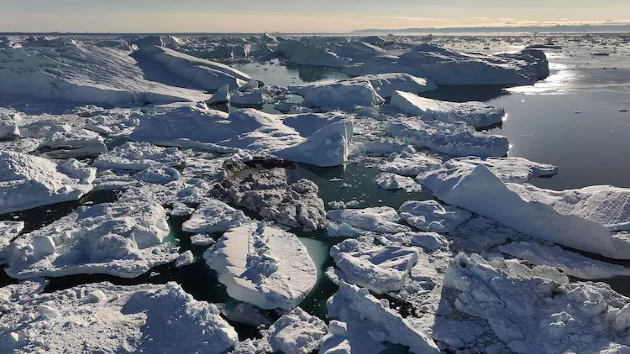
(NEW YORK) — Scientists are warning of a catastrophic sea level rise if the ice in the Arctic melts — a very real possibility.
The Arctic is the front line for climate change and the melting could have catastrophic effects on the rest of the world, experts say.
Researchers recently analyzed fossils taken from the center of the Greenland ice sheet, widely considered to be the largest annual contributor of water into the ocean. The fossils were found to have organic matter, indicating an ice-free period during the Pleistocene Epoch, about 400,000 years ago, according to a study published Monday in the Proceedings of the National Academy of Sciences.
The soil samples contained fragments of willow and wood, as well as insect parts, spike moss megaspores, fungi and poppy seeds, Halley Mastro, a graduate research assistant at the University of Vermont and co-author of the paper, told ABC News.
Paul Bierman, professor of natural resources and environmental science at the University of Vermont and lead author of the study, added: “There’s just no way around the fact that the ice must have been gone or otherwise you couldn’t have had these plants.”
If the Arctic can become ice-free without human interference, it certainly can do so again in the presence of anthropogenic, or human-caused, warming, Bierman said.
He noted that the fossil samples were derived from a drilling expedition in 1993, extracted from 2 miles beneath the ice shelf in Northwest Greenland, about 100 miles from the ice margin.
The fossilized plants suggest temperatures at Summit, Greenland, were likely about 37 to 44 degrees Fahrenheit when the ice disappeared, Mastro said. The ice was then replaced by a tundra ecosystem about 400,000 years ago. Carbon dioxide levels at that time are estimated to have been about 280 parts per million, compared to about 420 parts per million today, Bierman said.
The vast increase in carbon dioxide levels offer an explanation for current heat trends, Bierman added.
“The best thing we can do is to stop and is to get that carbon dioxide out of the atmosphere,” Bierman said. “That’s why we’re breaking heat records. It’s simply as though you’ve thrown a blanket over the Earth.”
Bierman and Mastro are part of a team of about 40 international researchers funded by the U.S. National Science foundation to look at materials from the bottom of ice cores.
Past marine sediment samples did not offer complete reconstructions of the ice sheet, which is why the analysis of the Arctic fossils is even more valuable, the researchers said. Moreover, the “remarkable preservation” of the macrofossils suggests that the ice sheet was completely ice-free during the Pleistocene period.
Data from NASA’s Grace satellite shows a drastic reduction in the mass of the Greenland ice sheet over the last two decades.
Not only is the ice sheet more unstable than previously thought, a paper published last year in PNAS found that it is also melting faster than scientists predicted — a combination that could quickly accelerate the disappearance of the ice sheet, Bierman said.
A 2019 paper published in Nature found that the melting of the Greenland ice sheet could expose 400 million people to flooding risk. The potential melting in Greenland will have impacts all over the world — coastal cities like Mumbai, Cape Town, New York, Boston and Miami could disappear, Bierman said.
Greenland’s three largest glaciers — Jakobshavn Isbræ, Kangerlussuaq and Helheimcould — could lose more ice than previously predicted if emissions continue as “business as usual,” a 2020 study published in Nature found. These glaciers make up about 12% of the entire ice sheet and hold enough ice to raise sea levels by about 4.3 feet.
Copyright © 2024, ABC Audio. All rights reserved.








